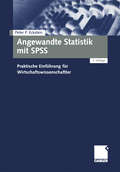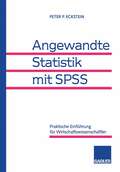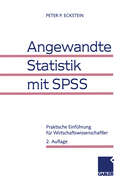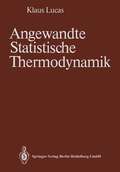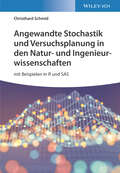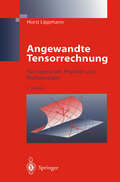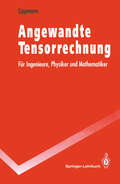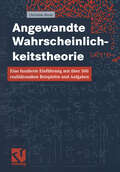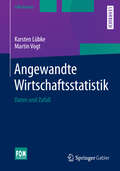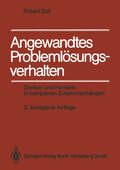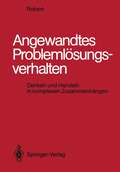- Table View
- List View
Angewandte Statistik mit SPSS: Praktische Einführung für Wirtschaftswissenschaftler
by Peter P. EcksteinPeter P. Eckstein stellt in diesem Buch klassische und moderne Verfahren der Deskriptiven und Induktiven Statistik, der Explorativen Datenanalyse sowie der Ökonometrie komprimiert dar. Unter Einsatz des Statistik-Software-Paketes SPSS für Windows werden sämtliche statistische Verfahren anhand praktischer Problemstellungen demonstriert und die Ergebnisse sachlogisch interpretiert. Die dritte, vollständig überarbeitete Auflage basiert auf der SPSS Version 10.0 für Windows. Zu jedem Kapitel gibt es Übungs- und Klausuraufgaben mit vollständigen Lösungen.
Angewandte Statistik mit SPSS: Praktische Einführung für Wirtschaftswissenschaftler
by Peter P. EcksteinPeter P. Eckstein stellt in diesem Buch klassische und moderne Verfahren der Deskriptiven und Induktiven Statistik, der Explorativen Datenanalyse sowie der Ökonometrie komprimiert dar. Unter Einsatz des Statistik-Software-Paketes SPSS für Windows werden sämtliche statistische Verfahren anhand praktischer Problemstellungen demonstriert und die Ergebnisse sachlogisch interpretiert. In sechs Kapiteln erfolgt eine schrittweise und anwendungsorientierte Einführung in die Thematik. Verzeichnis: Peter P. Eckstein stellt in diesem Buch klassische und moderne Verfahren der Deskriptiven und Induktiven Statistik, der Explorativen Datenanalyse sowie der Ökonometrie komprimiert dar. Unter Einsatz des Statistik-Software-Paketes SPSS für Windows werden sämtliche statistische Verfahren anhand praktischer Problemstellungen demonstriert und die Ergebnisse sachlogisch interpretiert. In den sechs Kapiteln SPSS für Windows, SPSS-Datenmanagement, Verteilungsanalyse, Mittelwertanalyse, Korrelationsanalyse und Regressionsanalyse erfolgt eine schrittweise und anwendungsorientierte Einführung in die Thematik.
Angewandte Statistik mit SPSS: Praktische Einführung für Wirtschaftswissenschaftler
by Peter P. EcksteinPeter P. Eckstein stellt in diesem Buch klassische und moderne Verfahren der Deskriptiven und Induktiven Statistik, der Explorativen Datenanalyse sowie der Ökonometrie komprimiert dar. Unter Einsatz des Statistik-Software-Paketes SPSS für Windows werden sämtliche statistische Verfahren anhand praktischer Problemstellungen demonstriert und die Ergebnisse sachlogisch interpretiert. Die zweite, vollständig überarbeitete Auflage basiert auf der SPSS Version 8.0 für Windows. Zu jedem Kapitel gibt es jetzt Übungs- und Klausuraufgaben mit vollständigen Lösungen.
Angewandte Stochastik und Versuchsplanung in den Natur- und Ingenieurwissenschaften: mit Beispielen in R und SAS
by Christhard SchmidDieses Praktikerbuch ist zum einen eine anwendungsnahe Einführung in die Wahrscheinlichkeitstheorie und Statistik. Zum anderen erklärt es die statistische Versuchsplanung, die für die Planung und saubere Auswertung von Versuchsreihen von entscheidender Wichtigkeit ist. Herleitungen und Beweise werden dabei ausführlich erläutert, ohne sich in mathematischen Details zu verlieren. In mehr als 160 Beispielen illustriert das Buch die Umsetzung alltagssprachlich formulierter Probleme in wahrscheinlichkeitstheoretische bzw. statistische Modelle - und deren Implementierung in R und SAS.
Angewandte Stochastik und Versuchsplanung in den Natur- und Ingenieurwissenschaften: mit Beispielen in R und SAS
by Christhard SchmidDieses Praktikerbuch ist zum einen eine anwendungsnahe Einführung in die Wahrscheinlichkeitstheorie und Statistik. Zum anderen erklärt es die statistische Versuchsplanung, die für die Planung und saubere Auswertung von Versuchsreihen von entscheidender Wichtigkeit ist. Herleitungen und Beweise werden dabei ausführlich erläutert, ohne sich in mathematischen Details zu verlieren. In mehr als 160 Beispielen illustriert das Buch die Umsetzung alltagssprachlich formulierter Probleme in wahrscheinlichkeitstheoretische bzw. statistische Modelle - und deren Implementierung in R und SAS.
Angewandte Tensorrechnung: Für Ingenieure, Physiker und Mathematiker
by Horst LippmannDieses Lehrbuch ist als Einführung zu verstehen, und zwar für Ingenieure, Physiker oder angewandte Mathematiker. Es beruht auf einer Vorlesung für Studenten höherer Semester und setzt Vorkenntnisse entsprechend den üblichen Lehrveranstaltungen in Mathematik und Mechanik voraus. Es werden Anwendungen der Tensorrechnung auf Probleme der Mechanik, der Elektrodynamik und anderer Bereiche behandelt. Den einzelnen Kapiteln sind Übungsaufgaben angefügt, die teilweise aufeinander aufbauen. Ihre Lösungen werden gesondert zusammengefaßt.
Angewandte Tensorrechnung: Für Ingenieure, Physiker und Mathematiker (Springer-Lehrbuch)
by Horst LippmannDie Tensorrechnung ist ein formaler, programmierbarer Kalkül von speziellem Nutzen in der angewandten Mathematik, in der theoretischen Physik und in den theoretisch oder numerisch orientierten Ingenieurwissenschaften. Hier lernt man frühzeitig, beispielsweise mit mechanischen Spannungen und Verformungen in festen, flüssigen oder gasförmigen Körpern sowie mit Trägheitsmomenten, Flächenkrümmungen und anderen Größen umzugehen, welche sogar dann Tensoren sind, wenn man es verschweigt. Die Kristallkunde beruht in ganz besonderem Maße auf der Tensorrechnung, und viele numerische Methoden der Kontinuumsphysik werden erst bei tensorieller Darstellung durchsichtig. Dieses Lehrbuch ist als Einführung zu verstehen, und zwar für Ingenieure, Physiker oder angewandte Mathematiker. Es beruht auf einer Vorlesung für Studenten höherer Semester und setzt Vorkenntnisse entsprechend den üblichen Lehrveranstaltungen in Mathematik und Mechanik voraus. Es werden Anwendungen der Tensorrechnung auf Probleme der Mechanik, der Elektrodynamik und anderer Bereiche behandelt. Den einzelnen Kapiteln sind Übungsaufgaben angefügt, die teilweise aufeinander aufbauen. Ihre Lösungen werden gesondert zusammengefaßt.
Angewandte Wahrscheinlichkeitstheorie: Eine fundierte Einführung mit über 500 realitätsnahen Beispielen und Aufgaben
by Christian H. HesseWahrscheinlichkeitstheoretische Grundbegriffe - Verteilungen - Grenzwertsätze - stochastische Abhängigkeit - stochastische Modelle - statistische Verfahren Das Buch bietet eine Einführung in die Stochastik für Studierende der Mathematik, Informatik, der Ingenieur- und Wirtschaftswissenschaften. Neben einer intuitiven Verankerung der Theorie wird großer Wert auf realitätsnahe Beispiele gelegt. Das Buch enthält eine Vielzahl dieser Anwendungen aus den verschiedensten Gebieten.
Angewandte Wirtschaftsstatistik: Daten und Zufall (FOM-Edition)
by Karsten Lübke Martin VogtKarsten Lübke und Martin Vogt führen in die Wirtschaftsstatistik ein. Dabei legen sie das Hauptaugenmerk auf die Vermittlung der Grundlagen der deskriptiven und induktiven Statistik. Sie zeigen, wie aus den allgegenwärtigen Daten Erkenntnisse gewonnen werden können, ohne dabei auf den Zufall hereinzufallen. Zahlreiche praxis- und berufsnahe Übungsaufgaben, Beispiele und Fallstudien aus unterschiedlichen Bereichen wie etwa Finance oder Marketing vertiefen und veranschaulichen die behandelten Themen. Die Autoren stellen die Praxis statistischer Verfahren dar, liefern die theoretischen Grundlagen und gehen sowohl auf berufspraktische und wissenschaftliche Aspekte als auch auf die Umsetzung am Computer ein, sodass die Verfahren von Studierenden und von Praktikern mit Gewinn eingesetzt werden können.
Angewandtes Problemlösungsverhalten: Denken und Handeln in komplexen Zusammenhängen
by Robert SellAus den Besprechungen: "... hat der Hochschuldidaktiker seine Technik in einem Lehrbuch über Angewandtes Problemlösungsverhalten veröffentlicht. Gedacht ist es zwar für Ingenieure und Studenten der Ingenieurwissenschaften. Doch abgesehen von einem kleinen Teil der Übungsaufgaben, bei dem etwas Physik vorausgesetzt wird, ist dieses broschierte Werk nützlich für jeden, der sich mit Problemen herumschlagen muß - oder möchte. Überdies vermittelt es dem Leser ein bißchen Lernpsychologie, dargeboten in einer verständlichen ... Sprache. ... Für Probleme anderer, höchst unterschiedlicher Art, für Streichholzspiele zum Beispiel, für das Wandern durch ein Labyrinth ... taugen Sells Lösungsrezepte ebenso gut. Zuerst gilt es, den Typ des vorliegenden Problems zu finden; dies geschieht nach der im Buch angebotenen Klassifizierung. Die jeweils dazugehörige, systematische Hinterfragungs-Strategie führt dann meistens rasch zum Erfolg. Auch dem, der das Bucch nicht als Gebrauchsanweisung verwenden möchte, bietet es Anregung zum Nachdenken über unser oft hilfloses Verhalten in kniffeligen Situationen..." Die Zeit#1
Angewandtes Problemlösungsverhalten: Denken und Handeln in komplexen Zusammenhängen
by Robert SellDies Buch wendet sich vor allem an Ingenieure; es bietet ein Training zum systematischen, methodischen und kreativen, produktiven Denken und Problemlöseverhalten. Die aus der Denkpsychologie bekannten Ansätze und Methoden werden in einer für Ingenieure geeigneten Art und Weise entwickelt und zusammengestellt. Entsprechend der Vielfalt von Problemsituationen wird dabei diese Systematik sowohl in allgemeiner Form, als auch für bestimmte Problemfelder in weitaus differenzierter Form vorgestellt. Ein allgemeines Ablaufdiagramm wird schrittweise mit konkreten Übungen entwickelt, erprobt und auf komplexe ingenieurwissenschaftliche Probleme angewandt. Die Differenzierung von Problemtypen und Lösungsabläufen verhindert eine mechanische Anwendung. Alle Ansätze und Methoden werden systematisch entwickelt; entsprechend der Vielfalt von Problemsituationen wird die Systematik sowohl allgemein als auch speziell für bestimmte Problemfelder vorgestellt. Heuristische Prinzipien, Pläne und Programme werden gesammelt, geordnet, klassifiziert und erweitert, so daß ein Repertoire von Handlungsmöglichkeiten für unterschiedliche Problemklassen zur Verfügung steht, die der Leser individuellen Bedürfnissen anpassen kann. Damit entspricht dieses Buch den Anforderungen sowohl der Ausbildung als auch der Berufspraxis und bietet für Studium und Selbststudium einen Leitfaden zum Training des systematischen, methodischen, dabei aber gleichzeitig kreativen und produktiven Denkens und Problemlösens; die Ausführungen erlauben eine effektivere Planung und Durchführung von Arbeiten.
Angle at centre of circle (large print)
by New College WorcesterThis diagram shows a circle with lines with marked angles. There is a locator dot shown, which will be at the top left of the page when the image is the correct way up. Two lines come from the centre of the circle and go down left and right to the circumference. Two longer lines go from the same two places on the circumference up left and right to the top of the circle. The long lines make an angle at the circumference marked x. The lines meeting at the centre of the circle make an angle marked 2x.
Angle at centre of circle (UEB contracted)
by New College WorcesterThis diagram shows a circle with lines with marked angles. There is a locator dot shown, which will be at the top left of the page when the image is the correct way up. Two lines come from the centre of the circle and go down left and right to the circumference. Two longer lines go from the same two places on the circumference up left and right to the top of the circle. The long lines make an angle at the circumference marked x. The lines meeting at the centre of the circle make an angle marked 2x.
Angle at centre of circle (UEB uncontracted)
by New College WorcesterThis diagram shows a circle with lines with marked angles. There is a locator dot shown, which will be at the top left of the page when the image is the correct way up. Two lines come from the centre of the circle and go down left and right to the circumference. Two longer lines go from the same two places on the circumference up left and right to the top of the circle. The long lines make an angle at the circumference marked x. The lines meeting at the centre of the circle make an angle marked 2x.
Angle bisector (large print)
by RnibThis page shows three small diagrams. There is a locator dot shown, which will be at the top left when the image is the correct way up. The diagrams are on the right of the page with instructions to the left. The first image is an angle with a compass centre point at its vertex. A wide arc has been drawn from this point. The second image shows compass centre points where the wide arc crossed the arms. A second and third arc has been drawn from these points. These arcs intersect each other. The last image shows a line drawn through the intersecting arcs to the vertex. This line bisects the original angle.
Angle bisector (UEB contracted)
by RnibThe diagrams are on the right of the page with instructions to the left. The first image is an angle with a compass centre point at its vertex. A wide arc has been drawn from this point. The second image shows compass centre points where the wide arc crossed the arms. A second and third arc has been drawn from these points. These arcs intersect each other. The last image shows a line drawn through the intersecting arcs to the vertex. This line bisects the original angle
Angle bisector (UEB uncontracted)
by RnibThis page shows three small diagrams. There is a locator dot shown, which will be at the top left when the image is the correct way up. The diagrams are on the right of the page with instructions to the left. The first image is an angle with a compass centre point at its vertex. A wide arc has been drawn from this point. The second image shows compass centre points where the wide arc crossed the arms. A second and third arc has been drawn from these points. These arcs intersect each other. The last image shows a line drawn through the intersecting arcs to the vertex. This line bisects the original angle.
Angle facts (large print)
by New College WorcesterThese four pages show diagrams of straight lines with marked angles. There is a locator dot shown, which will be at the top left of the page when the image is the correct way up. On the first page the top diagram is a horizontal line with a second line going up and to the right. The middle diagram is two diagonal lines crossing each other. The bottom diagram is the same but with the angles marked differently. The last three pages all have the same two patterns of lines. On the top of each page there are two horizontal arrows pointing to the right with a diagonal line going from the bottom left to the top right of the image. On the bottom of each page there are two vertical arrows pointing up with a diagonal line going from the top left to the bottom right of the image. The angles formed by these lines are marked by letters. This is different on each page.
Angle facts (UEB contracted)
by New College WorcesterThese four pages show diagrams of straight lines with marked angles. There is a locator dot shown, which will be at the top left of the page when the image is the correct way up. On the first page the top diagram is a horizontal line with a second line going up and to the right. The middle diagram is two diagonal lines crossing each other. The bottom diagram is the same but with the angles marked differently. The last three pages all have the same two patterns of lines. On the top of each page there are two horizontal arrows pointing to the right with a diagonal line going from the bottom left to the top right of the image. On the bottom of each page there are two vertical arrows pointing up with a diagonal line going from the top left to the bottom right of the image. The angles formed by these lines are marked by letters. This is different on each page.
Angle facts (UEB uncontracted)
by New College WorcesterThese four pages show diagrams of straight lines with marked angles. There is a locator dot shown, which will be at the top left of the page when the image is the correct way up. On the first page the top diagram is a horizontal line with a second line going up and to the right. The middle diagram is two diagonal lines crossing each other. The bottom diagram is the same but with the angles marked differently. The last three pages all have the same two patterns of lines. On the top of each page there are two horizontal arrows pointing to the right with a diagonal line going from the bottom left to the top right of the image. On the bottom of each page there are two vertical arrows pointing up with a diagonal line going from the top left to the bottom right of the image. The angles formed by these lines are marked by letters. This is different on each page.
Angle in a semicircle is 90 degrees (large print)
by New College WorcesterThis image shows a circle which contains a right angle triangle. There is a locator dot shown, which will be at the top left of the page when the image is the correct way up. The long side of the triangle is the diameter of the circle.
Angle in a semicircle is 90 degrees (UEB contracted)
by New College WorcesterThis image shows a circle which contains a right angle triangle. There is a locator dot shown, which will be at the top left of the page when the image is the correct way up. The long side of the triangle is the diameter of the circle.
Angle in a semicircle is 90 degrees (UEB uncontracted)
by New College WorcesterThis image shows a circle which contains a right angle triangle. There is a locator dot shown, which will be at the top left of the page when the image is the correct way up. The long side of the triangle is the diameter of the circle.
Angle properties (large print)
by New College WorcesterThese two pages each have three sets of lines making angles. Each angle is named and its property described. There is a locator dot shown, which will be at the top left of the page when the image is the correct way up.
